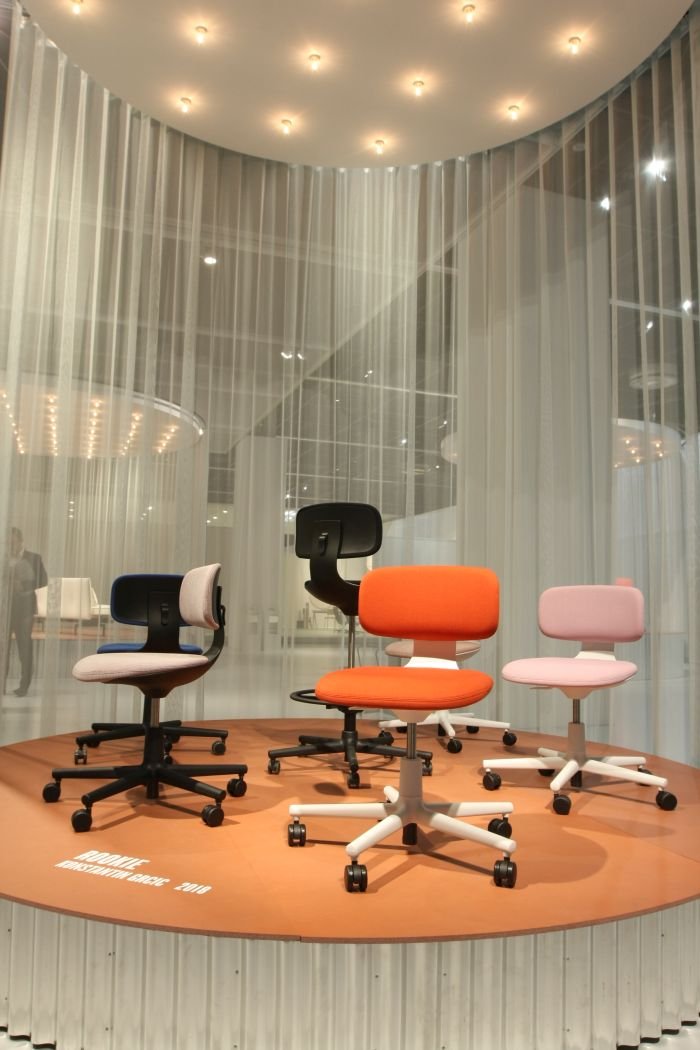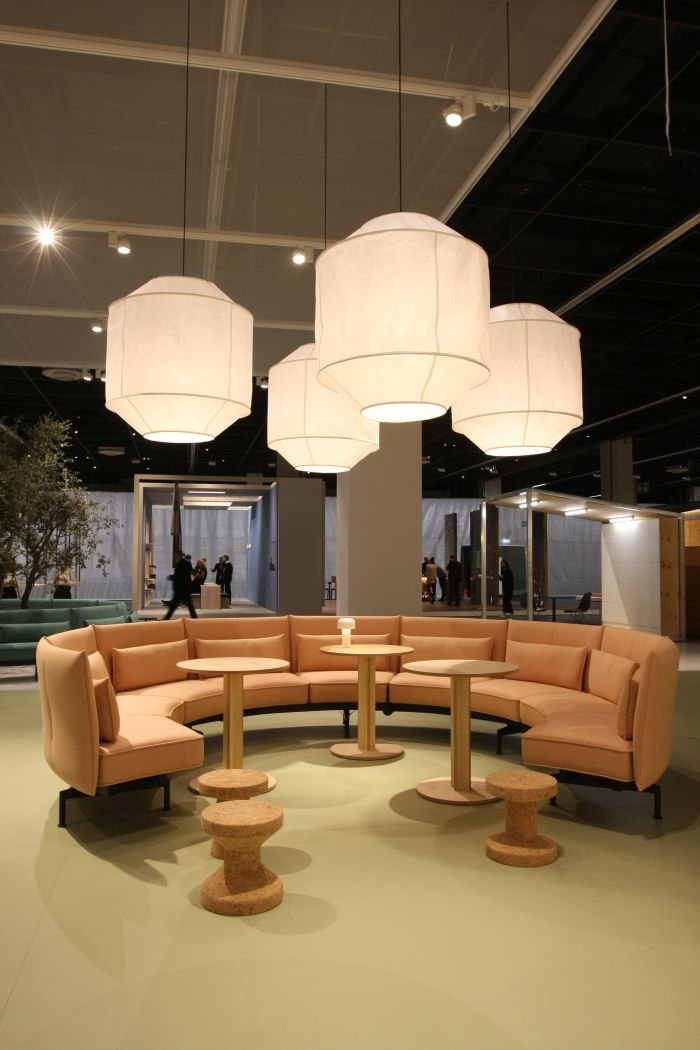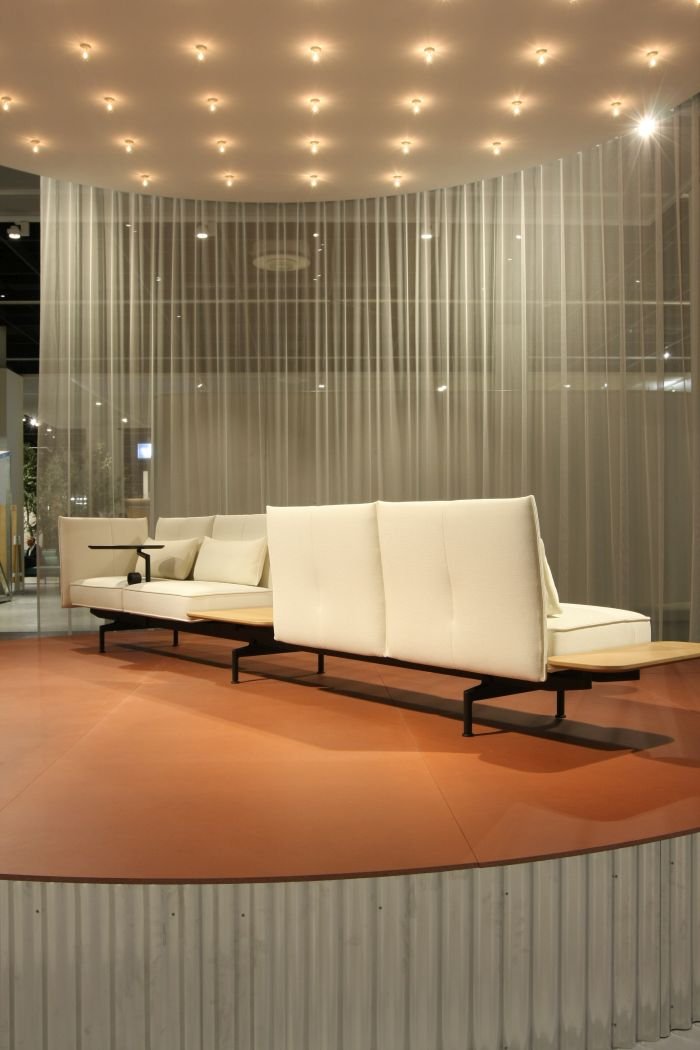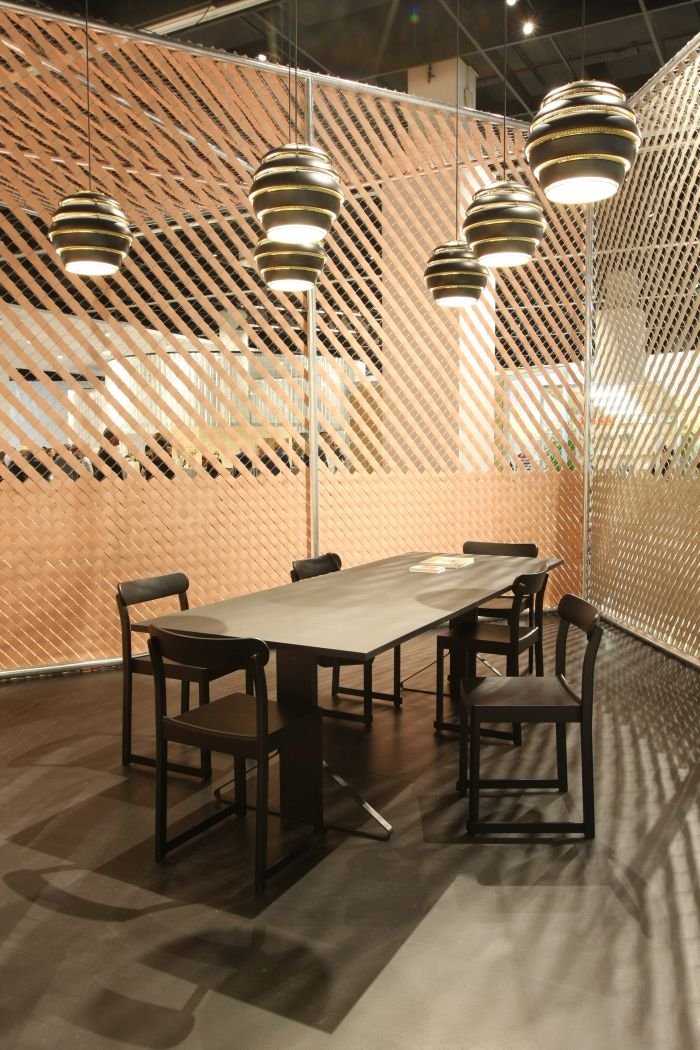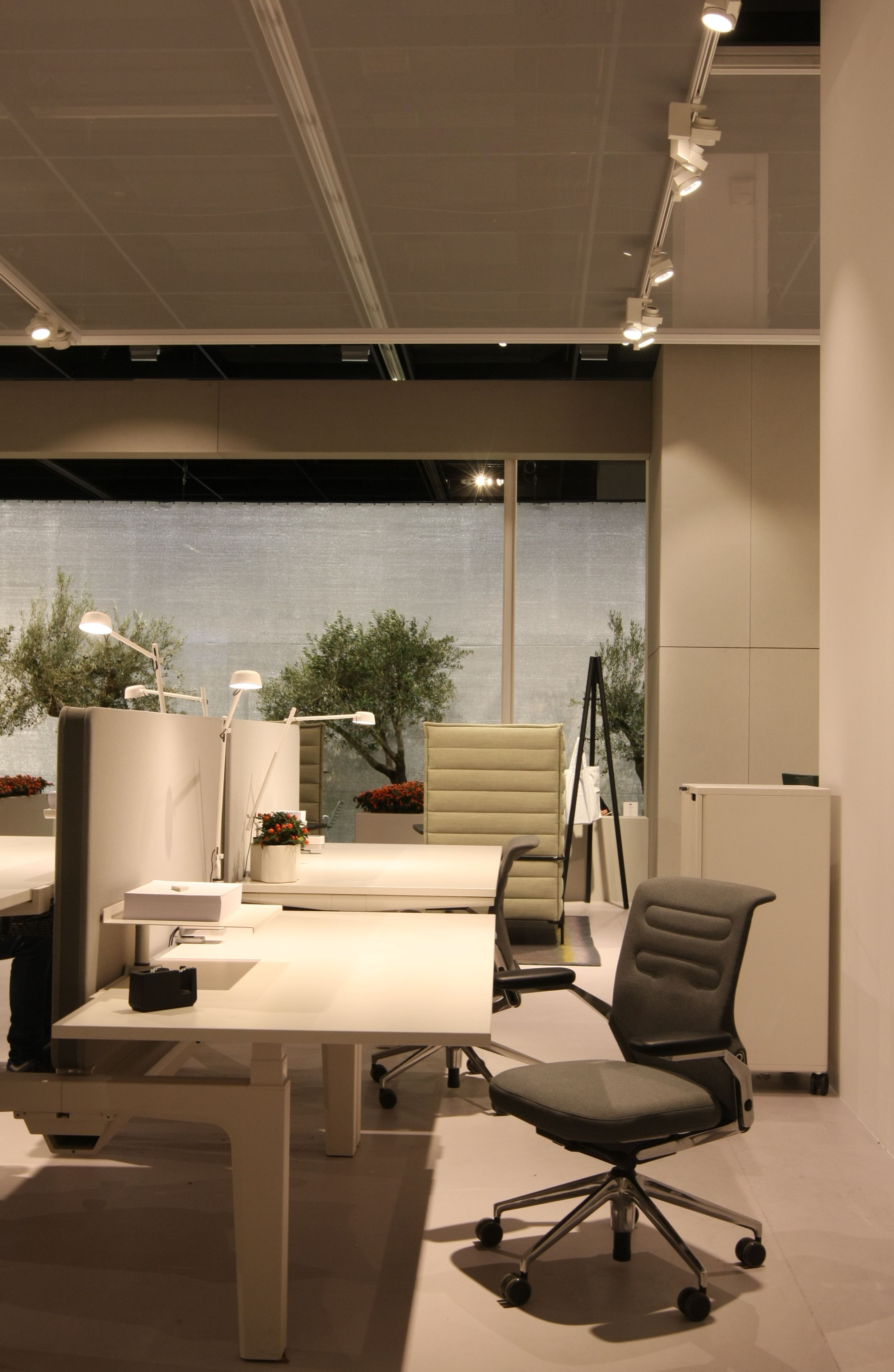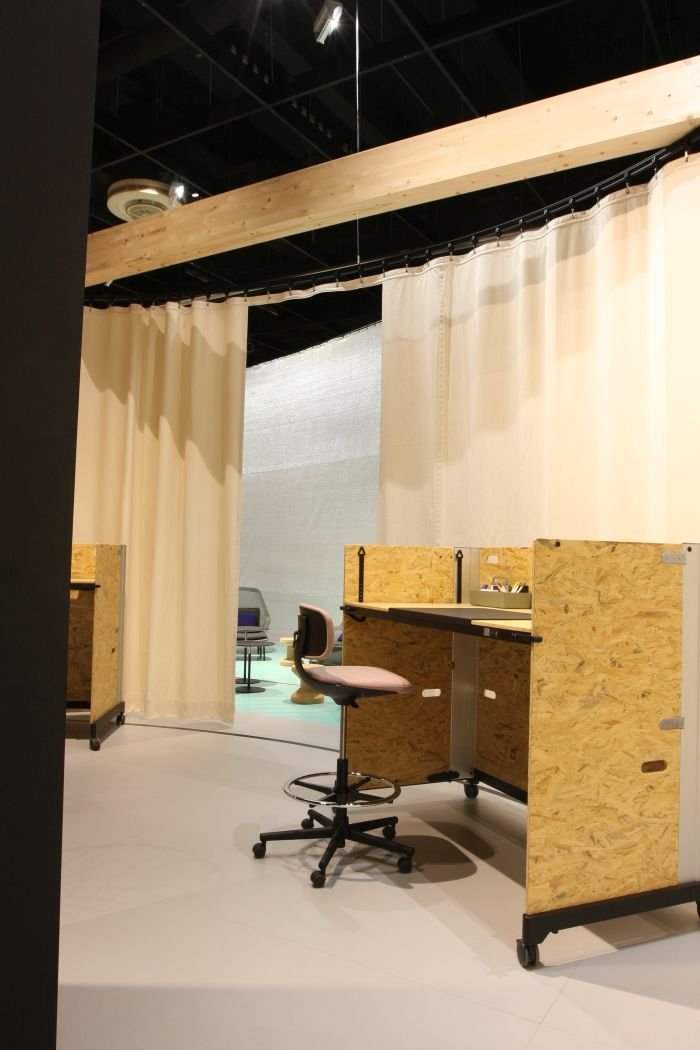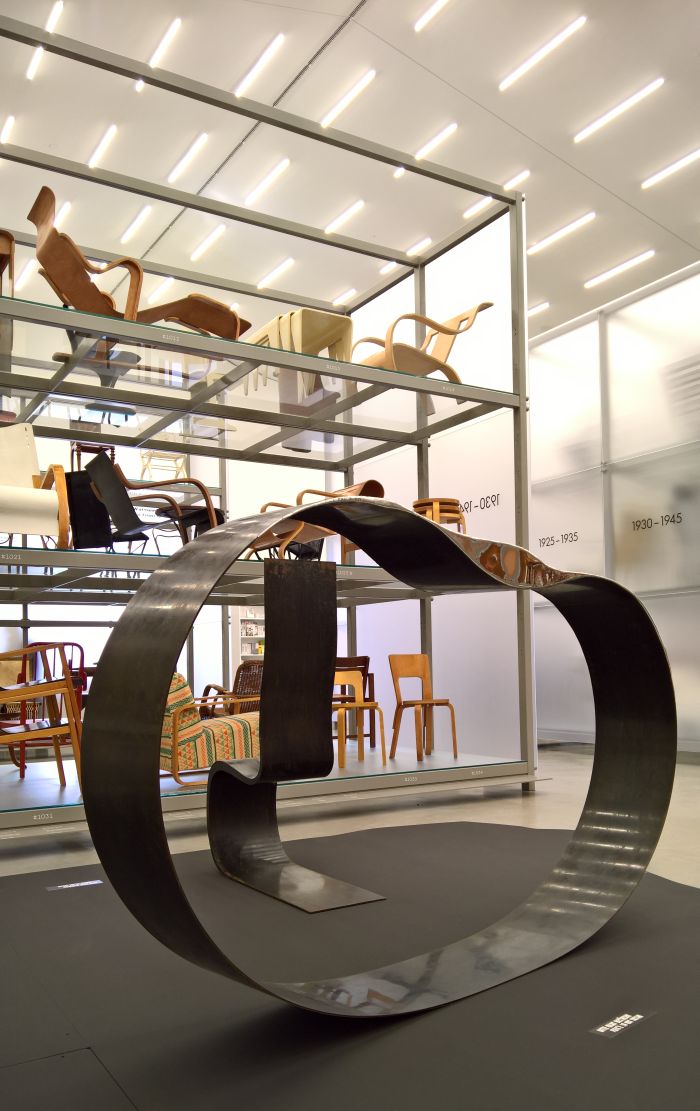Artek | Designer | Exhibitions and Shows | Office Furniture | orgatec | Producer | Product | Vitra
At Orgatec Cologne 2016 Vitra staged, in effect, their own trade fair, renting an entire hall and inviting family and friends along to share the space and their ideas on the future of work.
And obviously had a lot of fun and/or success with the concept.
For at Orgatec Cologne 2018 they once again staged the Vitra Fair....... Work
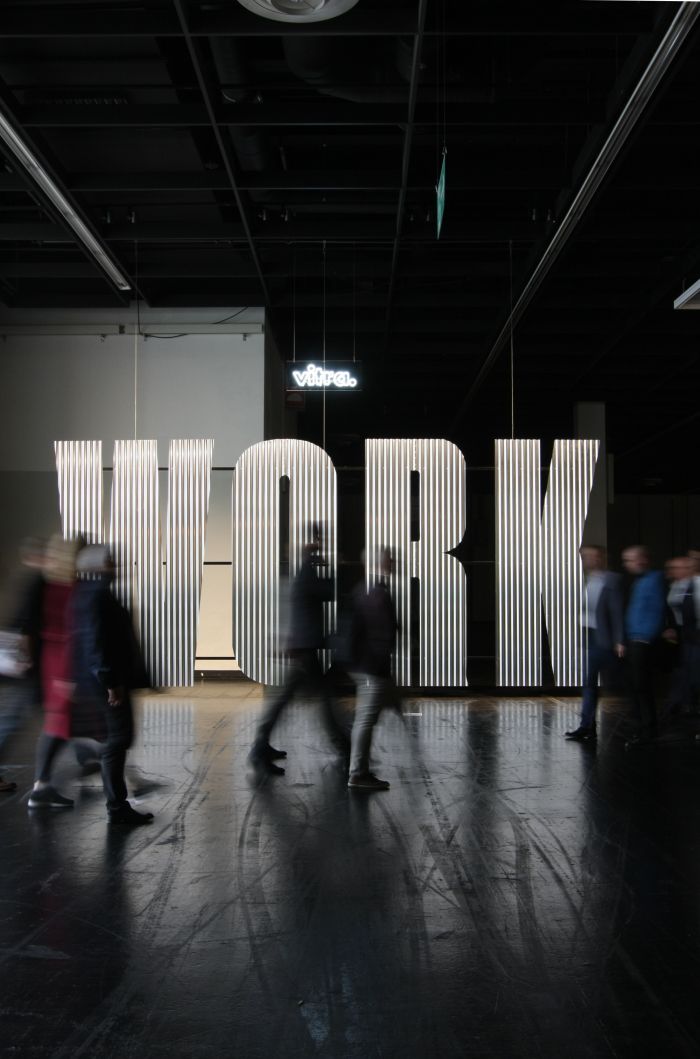
Back in our post from the Vitra Design Museum Schaudepot's exhibition Ron Arad: Yes to the Uncommon! we hinted that if Vitra didn't use Orgatec Cologne 2018 to launch Arad's 1990 Bucking Bronco concept as an object of office furniture, we'd be heartbroken.
They didn't.
We are.
Thanks Vitra!
However, we're well versed in disappointment management, in the art of lying to ourselves that it's all for the best, and thus found the strength to focus on that which Vitra did present at Orgatec 2018.
Although the (popular) (hi)story of Vitra is inextricably linked with designers such as Charles and Ray Eames, George Nelson or Verner Panton, and for all domestic furniture, the more complete (hi)story of Vitra is one largely based on office furniture.
As we discussed in context of our 2016 Neocon Chicago interview with Vitra's Chief Sales Officer, Josef Kaiser, Vitra's first foray into the world of office furniture came in 1976 with the Vitramat chair; a name unequivocally, 100%, off its time, and a work that was realised in a cooperation between the designer Wolfgang Müller-Deisig and the Vitra in-house engineering team led by Egon Bräuning, working together to create something that was technically and aesthetically refined, technically and aesthetically new. Further office chairs in the same spirit from Mario Bellini and Antonio Citterio followed before in 1991 with Citizen Office Vitra embarked on, arguably, their most important office project: reflections on the future of the work environment, a project which the, then, Vitra CEO Rolf Fehlbaum noted was "ein Projekt mit ungewissem Ausgang"1 - "a project with an uncertain outcome."
Work at Orgatec Cologne 2018 saw Vitra take their next step towards that Ausgang.
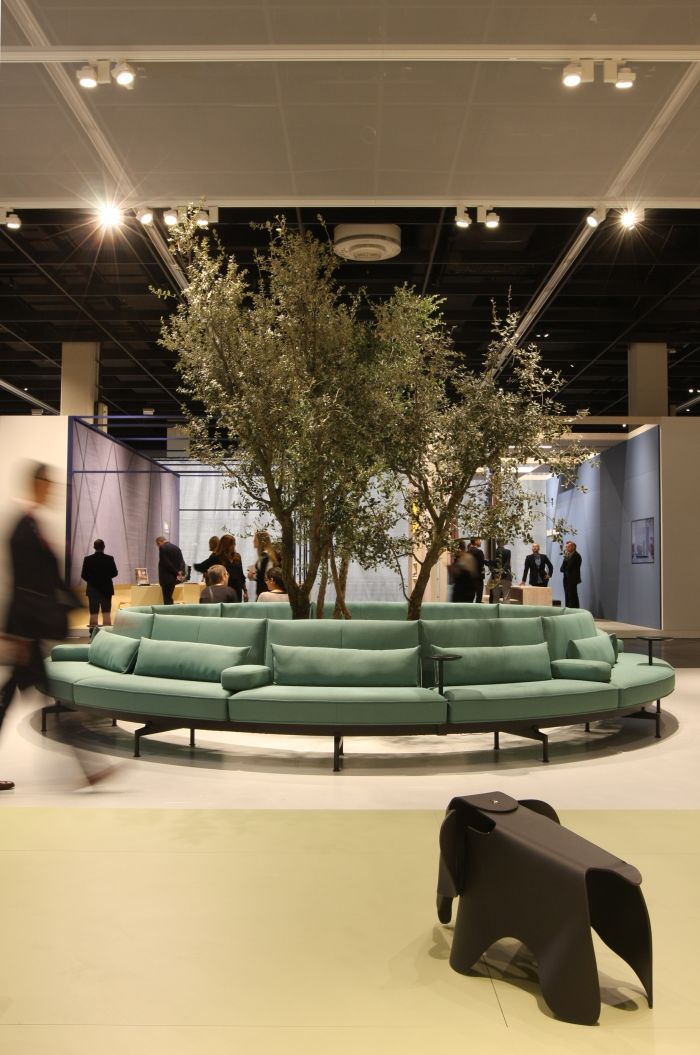
In a same-same-but-different take on Work 2016 the central component of Work 2018 was three office space proposals: Edward Barber & Jay Osgerby presenting their Shared Office which envisaged an informal working environment inspired by hotel lobbies and cafés; Konstantin Grcic's Super Flexible Office conceived as a, well, super flexible office, with nothing nailed down and all relationships up for discussion; while long term Vitra office concept collaborator, Sevil Peach, presented with her Company Home proposal the office as an integrated, integral, near borderless, component of the wider space in which it stands.
In a same-same-but-different take on Work 2016 we'll (more or less) ignore the three proposals per se, and instead (very loosely) consider the discussion staged with the four, together with Pernilla Ohrstedt and Jonathan Olivares who were responsible for the complete installation, and a discussion which moved over considerations on subjects such as the office as a public space, the relationship between the office worker and their office space, the demographics of work, soft ergonomics, but for all the question of where and how to work.
A question which implies that you have a choice.
A choice the vast majority don't have. The vast majority of office workers having to work in/on/with that which is supplied.
A fact which therefore makes the question irrelevant?
Far from it. Makes it very relevant, almost fundamental, not least because understanding this lack of choice shifts the focus from the where and the how to the why: why are we working here and in this way?
Or put another way, why did those responsible make this decision? Why this option?
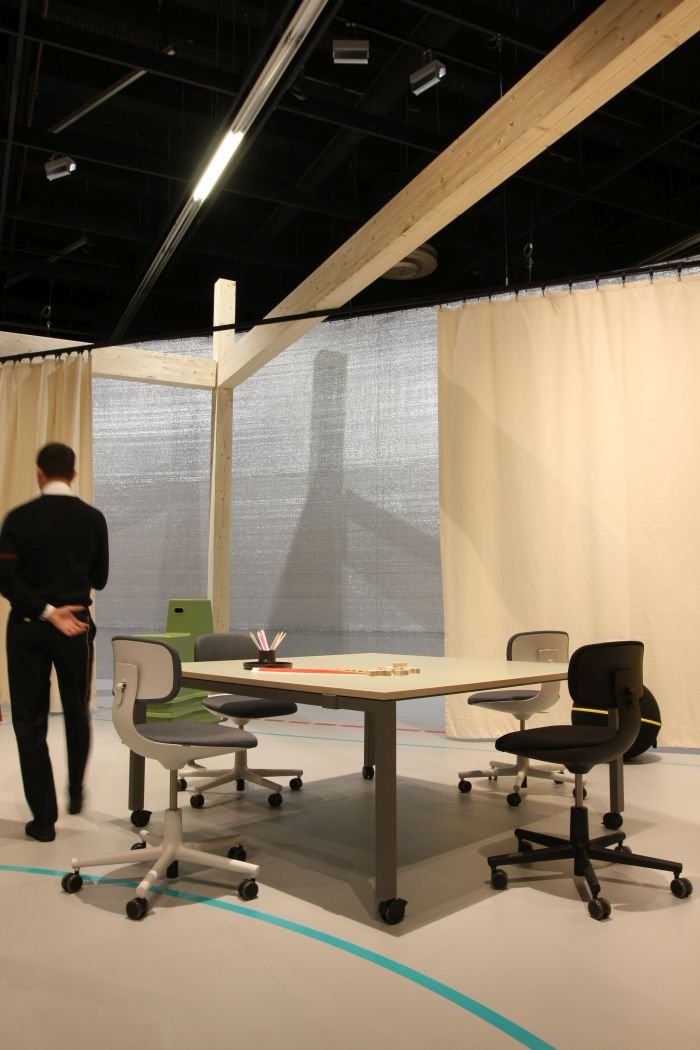
Sitting listening to the discussion - including a whole collection of views, or perhaps better put, denunciations, on desks which indicate all participants need to urgently listen to Harry Nilsson's Good Old Desk as featured in our Office Furniture Playlist - and then subsequently reflecting on that discussion while touring the other, non-Vitra, Orgatec halls, we found ourselves continually returning to the where/how/why question, that and soft ergonomics, but we'll save that for another day. And for all we found ourselves returning to the unmistakable impression that a lot of understandings about contemporary/future office environments, a lot of the public discourse on contemporary/future office environments is/are based on how digital/social/media companies work, about the ideological environments architects create for shiny co-working conglomerates, and, and as was repeated several times in context of the Vitra Work 2018 discussion, the fact that freelancers work in cafés and similar public spaces.
So do we.
We have a smow blog office, a lovely office with all our hearts could desire, apart from shelving, we've no shelves, #smowblogfact; however, the nature of what we do means that the vast majority of this blog is written outwith the office, over the years we've composed posts from locations as varied as, and amongst many, many others, museum foyers, high-speed international trains, college cafeterias, low-speed regional trains, libraries, railway station lounges, planes, balconies, railway station platforms, hostel dining rooms, buses, on horseback, in parks, living rooms, underground trains and the occasional café. In many regards we are textbook examples of itinerant office workers, of those contemporary office workers whose workplace is temporary, informal, often poorly heated, increasingly soft-furnished.
The point is, we don't do such because we want to. But because we have to, needs must; until now no-one has staged an exhibition in our office, no-one has staged a trade fair in our office, no-one has staged a design week in our office, thankfully, as it would mean vacuuming, which we can't, because we have no shelves, so the floor's full; and because no-one comes to us, we must go to them, then on to them, to them, to them, to Belgium. And work wherever we find a convenient corner. And ideally a plug.
And while we're perfectly happy working in such locations and under such conditions, can be extremely productive, all the time we are yearning for our office, for our desk and our swivel chair.
And so on a personal level it's very hard to convince us that following the example of the contemporary practices of the digital, and for all freelance, economies are the best option. Not least because we suspect we're not alone in our position. Suspect amongst a lot of the global café squatting freelancers there are a majority whose thoughts are in a swivel chair. And far, far away from the person holding a telephone conversation, that's really just a shamelessly advanced game of Buzzword Bingo, and is doing such in an unnaturally loud voice, at a volume inappropriate for a café. And is doing such because they are wearing wireless EarPods and therefore are invisible and inaudible. A start-up stealth bomber. But we digress, that's more considerations on the office as a public space. Which it is. But isn't a public space in the way other public spaces are public spaces. But we'll return to that another day.
But more fundamentally, in promoting office environment concepts on the argument that freelancers work in cafés, digital media types work on sofas, co-workers in the ideological environment an architect has created, we see the risk that it increasingly becomes an argument, and thereby a discourse, based on objects rather than practices, and ultimately we'll end up with cubicles.
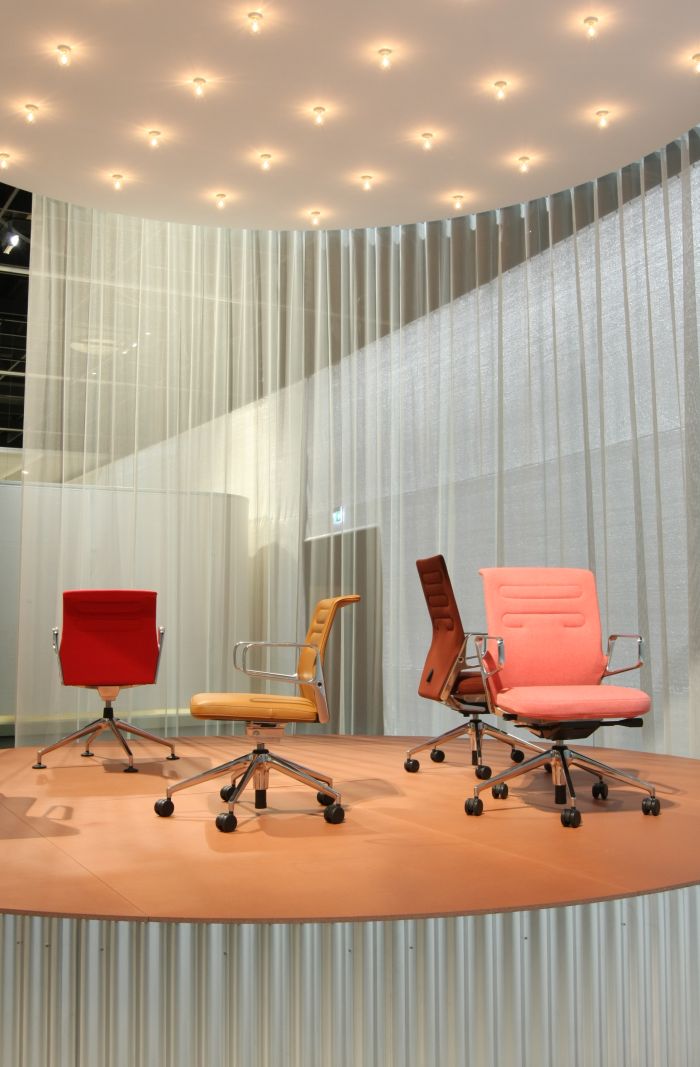
OK not cubicles directly, but something akin.
But let's first go back a step to the 1950s and Florene Knoll.
As previously discussed, through her role within the Knoll Planning Unit, Florence Knoll was a leading figure in the establishment of new ideas in terms of approaching office design, not least through propagating an approach which involved an analysis of the way people work, the routes they travelled within the office space, why that was, and thereby an approach which had the practices within the office at its core.
In contrast, in our interview with former Herman Miller staffer, and Bob Propst collaborator, Tom Newhouse, he opined that the rise of the office cubicle was due to facility managers realising "that with square cubicles they could cram more people into a given space", whereby it became an object based solution, economic yes, but an object based economic solution.
And thereby one office workers rejected because it didn't fit in with their practices. Because that's how integrated systems function, integrated systems have feedback loops to prevent damage, feedback loops which, in effect, reject that which is toxic, or that which doesn't concur with and/or inhibits, disrupts, its practices. And an office is an integrated system.
Similarly, the practices of tech companies, co-workers and freelancers may work perfectly well for them, may fit in with their practices and processes, ours certainly do us; but that doesn't mean they will concur with those of other office workers, now, or we'd argue, though for reasons of brevity not here, in the future.
And if you simply transfer the concepts of one sector to another, impose, if you will, objects that dictate practices, that will inevitably lead to rejection, will lead to the omnipresent informal, flexible, soft-furnished solutions becoming as detested and maligned as the cubicle.
Which isn't to say one shouldn't consider transposing elements of one sector into another, isn't to say that sectors can't learn and experience from one another, one should and they can, is however to understand that an office is a integrated system.
An integrated system which ever changing technical, social, economic and political realities means is in continual flux.
A state of affairs which in many regards makes Rolf Fehlbaum's uncertain outcome, much more an unreachable outcome. One that no matter how close one gets to, is always just about to skip off. But one that it is still essential to pursue.
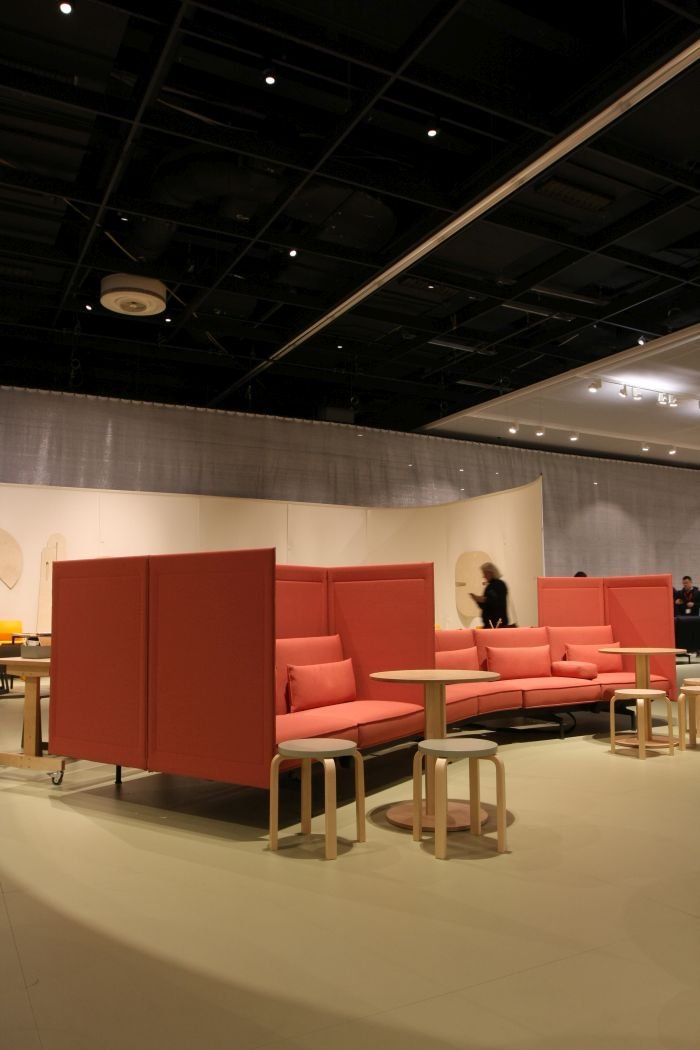
A key moment for us in the Vitra Work 2018 discussion was Konstantin Grcic's statement about the importance of each individual finding their identity within an office environment. A statement which initially led us to Søren Kierkegaard's reflections on faith in context of the individual's relation to the universal and the absolute, and for all which teleological suspensions one has to make to achieve an optimal office environment? Thankfully then very quickly led us further to the very simple truism that if you create a space someone wants to work in, they will better identify with the space, their job, and will be happier and more productive.
Which is obvious. And very complicated. Isn't something that can be achieved with Instagram. Certainly isn't something that can be achieved from a furniture manufacturers portfolio alone. Much more it necessitates a comprehensive understanding of the specific office environment, the specific office (eco)system.
Which means one can consider it as being comparable with evolution: evolution is, as with the development of office environments, universal, ceaseless, gradual, but always species, location and environment specific. Elephant's weren't forced to have trunks. Trunks make sense for elephants. Trunks don't make sense for pandas. Two thumbs make sense for pandas. And not all office solutions make sense for all office species, locations and environments. The correct ones must be allowed to evolve within that space.
Which doesn't answer the question of how to approach contemporary office environments. But for us does indicate a possible framework.
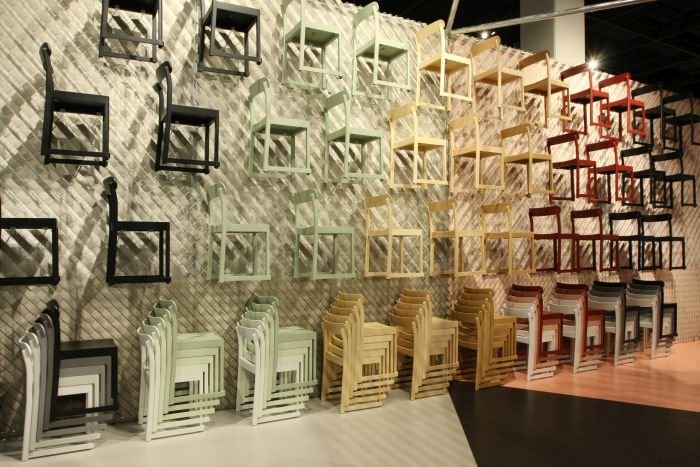
The essence of the approach Florence Knoll practised in the 1950s remains largely valid, however the evolution of understandings of design since then means it is no longer sufficient on its own.
Or as Andrea Branzi noted in context of Citizen Office, "interestingly, during our collaboration, we, for a long time, didn't talk about "the office", how it is, and how to improve it", much more they considered more general questions, questions of "the city and society, everyday life and technology"2
And for us the combination of the two is the key to considerations on future office environments, to consider the office as part of wider social, cultural, technological and economic system and then consider what that means in terms of the individual, but based not on an abstract, universal individual, but on the reality of what a specific individual actually does in a specific space and context.
Or put another way, in context of Citizen Office Rolf Fehlbaum noted, "although "the human at the centre" is regularly bestirred in office furniture manufacturing industry adverts, in reality they are being moved ever more to the margins"3
Avoiding such, and ensuring that the answer to the above posed question, "why are we working here and in this way?" is, "not sure, but I'm glad we are", is on the one hand a simple question of respect, of respecting the individual as an individual, not simply relating to them a cost-point on a spreadsheet, and on the other ensuring that they have the tools they need to allow them to achieve that for which they are employed. Importantly, and as with both Florence Knoll and Citizen Office, and in contrast to cubicles, the tools come at the very end, once everything else has been defined.
The Vitra Fair at Orgatec 2018 was called "Work", not "Office", "Office Furniture", "Office Design", "Future Office", "Future Office Furniture Design." And there's a huge, fundamental, difference. Work involves process. All the rest objects.
Yes the three proposals presented in Cologne were object heavy proposals, Vitra object heavy proposals, new Vitra object heavy proposals, including Konstantin Grcic's new Rookie office chair, Antonio Citterio's new AC 5 office chair family, and Barber & Osgerby's new Soft Work modular seating system, but it was trade fair, ¯\_(ツ)_/¯ ; however, in essence the three scenarios were based on the responsible creatives considerations on how the office environment relates to the wider world and the consequences therein. They may not all have been right. Certainly weren't in terms of the future of desks and swivel chairs. Office Furniture Playlist, it's all there. But then no one is. Least of all us. We don't even have shelves. Important is that an open and honest discourse occurs in context of which a varied range of voices are heard.
Whereby, and as with Vitra Work 2016, we did miss the more experimental positions, do still consider it odd that having invited so many friends and family to the discussion that Vitra didn't invite a few younger designers, architects and/or artists to develop proposals, to explore more divergent/radical/less Vitra product heavy, positions on the future of society and its relation to the future of the office environment. It's the sort of thing one expects from Vitra. And for us would not only have completed the presentation and helped underscore the Vitra approach, but we believe would also have greatly assisted the move towards, or perhaps better put, the pursuit of, that uncertain, unreachable outcome.
And what better method is there to pursue an unreachable outcome than on an improbable bouncing steel hoop..........?
1Rolf Fehlbaum "Ein Projekt mit ungewissem Ausgang" in Citizen Office. Ideen und Notizen zu einer neuen Bürowelt, Alexander von Vegesack [Ed.] Steidl Verlag, Göttingen, 1994
2Andrea Branzi, "Citizen Office - eine Einleitung" in Citizen Office. Ideen und Notizen zu einer neuen Bürowelt, Alexander von Vegesack [Ed.] Steidl Verlag, Göttingen, 1994
3Rolf Fehlbaum "Ein Projekt mit ungewissem Ausgang" in Citizen Office. Ideen und Notizen zu einer neuen Bürowelt, Alexander von Vegesack [Ed.] Steidl Verlag, Göttingen, 1994
Full details on Vitra Work 2018 can be found at www.vitra.com/orgatec2018
